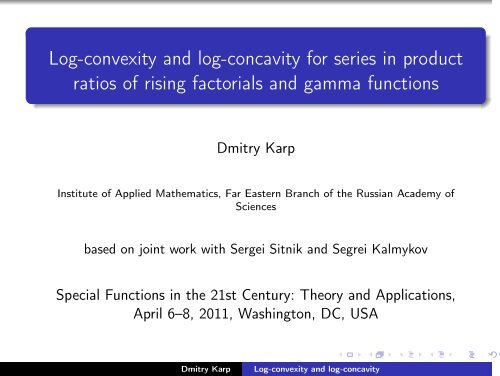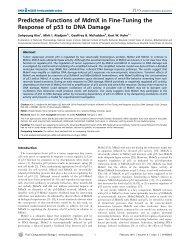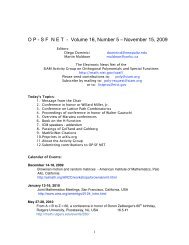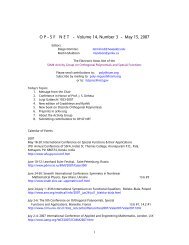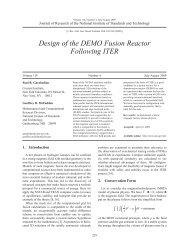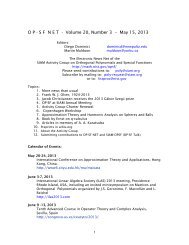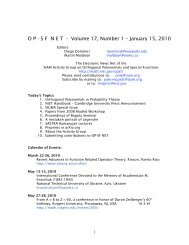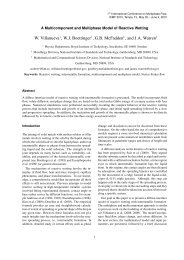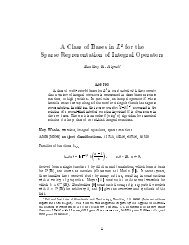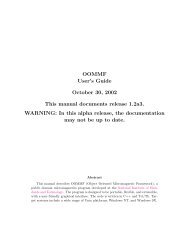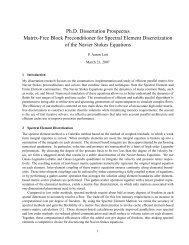Dmitry Karp - Math, Statistics, and Computational Science
Dmitry Karp - Math, Statistics, and Computational Science
Dmitry Karp - Math, Statistics, and Computational Science
You also want an ePaper? Increase the reach of your titles
YUMPU automatically turns print PDFs into web optimized ePapers that Google loves.
Log-convexity <strong>and</strong> log-concavity for series in product<br />
ratios of rising factorials <strong>and</strong> gamma functions<br />
<strong>Dmitry</strong> <strong>Karp</strong><br />
Institute of Applied <strong>Math</strong>ematics, Far Eastern Branch of the Russian Academy of<br />
<strong>Science</strong>s<br />
based on joint work with Sergei Sitnik <strong>and</strong> Segrei Kalmykov<br />
Special Functions in the 21st Century: Theory <strong>and</strong> Applications,<br />
April 6–8, 2011, Washington, DC, USA<br />
<strong>Dmitry</strong> <strong>Karp</strong> Log-convexity <strong>and</strong> log-concavity
Log-concavity <strong>and</strong> log-convexity<br />
Definition of log-concavity <strong>and</strong> log-convexity<br />
A continuous function f : (a, b) → R+ is log-concave on (a, b) if for<br />
any δ > 0 <strong>and</strong> µ such that [µ − δ, µ + δ] ⊂ (a, b)<br />
If inequality (1) is reversed f is log-convex.<br />
f (µ) 2 ≥ f (µ + δ)f (µ − δ). (1)<br />
Some properties of log-convexity <strong>and</strong> log-concavity:<br />
Log-convexity is stronger then convexity<br />
Log-convexity is additive<br />
Log-convexity is not preserved by convolution<br />
Log-concavity is weaker than concavity<br />
Log-concavity is not additive<br />
Log-concavity is preserved by convolution<br />
Log-concavity <strong>and</strong> log-convexity are both preserved by binomial<br />
convolution<br />
<strong>Dmitry</strong> <strong>Karp</strong> Log-convexity <strong>and</strong> log-concavity
Log-concavity <strong>and</strong> log-convexity<br />
Definition of log-concavity <strong>and</strong> log-convexity<br />
A continuous function f : (a, b) → R+ is log-concave on (a, b) if for<br />
any δ > 0 <strong>and</strong> µ such that [µ − δ, µ + δ] ⊂ (a, b)<br />
If inequality (1) is reversed f is log-convex.<br />
f (µ) 2 ≥ f (µ + δ)f (µ − δ). (1)<br />
Some properties of log-convexity <strong>and</strong> log-concavity:<br />
Log-convexity is stronger then convexity<br />
Log-convexity is additive<br />
Log-convexity is not preserved by convolution<br />
Log-concavity is weaker than concavity<br />
Log-concavity is not additive<br />
Log-concavity is preserved by convolution<br />
Log-concavity <strong>and</strong> log-convexity are both preserved by binomial<br />
convolution<br />
<strong>Dmitry</strong> <strong>Karp</strong> Log-convexity <strong>and</strong> log-concavity
Log-concavity <strong>and</strong> log-convexity<br />
Definition of log-concavity <strong>and</strong> log-convexity<br />
A continuous function f : (a, b) → R+ is log-concave on (a, b) if for<br />
any δ > 0 <strong>and</strong> µ such that [µ − δ, µ + δ] ⊂ (a, b)<br />
If inequality (1) is reversed f is log-convex.<br />
f (µ) 2 ≥ f (µ + δ)f (µ − δ). (1)<br />
Some properties of log-convexity <strong>and</strong> log-concavity:<br />
Log-convexity is stronger then convexity<br />
Log-convexity is additive<br />
Log-convexity is not preserved by convolution<br />
Log-concavity is weaker than concavity<br />
Log-concavity is not additive<br />
Log-concavity is preserved by convolution<br />
Log-concavity <strong>and</strong> log-convexity are both preserved by binomial<br />
convolution<br />
<strong>Dmitry</strong> <strong>Karp</strong> Log-convexity <strong>and</strong> log-concavity
Log-concavity <strong>and</strong> log-convexity<br />
Definition of log-concavity <strong>and</strong> log-convexity<br />
A continuous function f : (a, b) → R+ is log-concave on (a, b) if for<br />
any δ > 0 <strong>and</strong> µ such that [µ − δ, µ + δ] ⊂ (a, b)<br />
If inequality (1) is reversed f is log-convex.<br />
f (µ) 2 ≥ f (µ + δ)f (µ − δ). (1)<br />
Some properties of log-convexity <strong>and</strong> log-concavity:<br />
Log-convexity is stronger then convexity<br />
Log-convexity is additive<br />
Log-convexity is not preserved by convolution<br />
Log-concavity is weaker than concavity<br />
Log-concavity is not additive<br />
Log-concavity is preserved by convolution<br />
Log-concavity <strong>and</strong> log-convexity are both preserved by binomial<br />
convolution<br />
<strong>Dmitry</strong> <strong>Karp</strong> Log-convexity <strong>and</strong> log-concavity
Log-concavity <strong>and</strong> log-convexity<br />
Definition of log-concavity <strong>and</strong> log-convexity<br />
A continuous function f : (a, b) → R+ is log-concave on (a, b) if for<br />
any δ > 0 <strong>and</strong> µ such that [µ − δ, µ + δ] ⊂ (a, b)<br />
If inequality (1) is reversed f is log-convex.<br />
f (µ) 2 ≥ f (µ + δ)f (µ − δ). (1)<br />
Some properties of log-convexity <strong>and</strong> log-concavity:<br />
Log-convexity is stronger then convexity<br />
Log-convexity is additive<br />
Log-convexity is not preserved by convolution<br />
Log-concavity is weaker than concavity<br />
Log-concavity is not additive<br />
Log-concavity is preserved by convolution<br />
Log-concavity <strong>and</strong> log-convexity are both preserved by binomial<br />
convolution<br />
<strong>Dmitry</strong> <strong>Karp</strong> Log-convexity <strong>and</strong> log-concavity
Log-concavity <strong>and</strong> log-convexity<br />
Definition of log-concavity <strong>and</strong> log-convexity<br />
A continuous function f : (a, b) → R+ is log-concave on (a, b) if for<br />
any δ > 0 <strong>and</strong> µ such that [µ − δ, µ + δ] ⊂ (a, b)<br />
If inequality (1) is reversed f is log-convex.<br />
f (µ) 2 ≥ f (µ + δ)f (µ − δ). (1)<br />
Some properties of log-convexity <strong>and</strong> log-concavity:<br />
Log-convexity is stronger then convexity<br />
Log-convexity is additive<br />
Log-convexity is not preserved by convolution<br />
Log-concavity is weaker than concavity<br />
Log-concavity is not additive<br />
Log-concavity is preserved by convolution<br />
Log-concavity <strong>and</strong> log-convexity are both preserved by binomial<br />
convolution<br />
<strong>Dmitry</strong> <strong>Karp</strong> Log-convexity <strong>and</strong> log-concavity
Log-concavity <strong>and</strong> log-convexity<br />
Definition of log-concavity <strong>and</strong> log-convexity<br />
A continuous function f : (a, b) → R+ is log-concave on (a, b) if for<br />
any δ > 0 <strong>and</strong> µ such that [µ − δ, µ + δ] ⊂ (a, b)<br />
If inequality (1) is reversed f is log-convex.<br />
f (µ) 2 ≥ f (µ + δ)f (µ − δ). (1)<br />
Some properties of log-convexity <strong>and</strong> log-concavity:<br />
Log-convexity is stronger then convexity<br />
Log-convexity is additive<br />
Log-convexity is not preserved by convolution<br />
Log-concavity is weaker than concavity<br />
Log-concavity is not additive<br />
Log-concavity is preserved by convolution<br />
Log-concavity <strong>and</strong> log-convexity are both preserved by binomial<br />
convolution<br />
<strong>Dmitry</strong> <strong>Karp</strong> Log-convexity <strong>and</strong> log-concavity
Log-concavity <strong>and</strong> log-convexity<br />
Definition of log-concavity <strong>and</strong> log-convexity<br />
A continuous function f : (a, b) → R+ is log-concave on (a, b) if for<br />
any δ > 0 <strong>and</strong> µ such that [µ − δ, µ + δ] ⊂ (a, b)<br />
If inequality (1) is reversed f is log-convex.<br />
f (µ) 2 ≥ f (µ + δ)f (µ − δ). (1)<br />
Some properties of log-convexity <strong>and</strong> log-concavity:<br />
Log-convexity is stronger then convexity<br />
Log-convexity is additive<br />
Log-convexity is not preserved by convolution<br />
Log-concavity is weaker than concavity<br />
Log-concavity is not additive<br />
Log-concavity is preserved by convolution<br />
Log-concavity <strong>and</strong> log-convexity are both preserved by binomial<br />
convolution<br />
<strong>Dmitry</strong> <strong>Karp</strong> Log-convexity <strong>and</strong> log-concavity
Log-concavity <strong>and</strong> log-convexity<br />
Definition of log-concavity <strong>and</strong> log-convexity<br />
A continuous function f : (a, b) → R+ is log-concave on (a, b) if for<br />
any δ > 0 <strong>and</strong> µ such that [µ − δ, µ + δ] ⊂ (a, b)<br />
If inequality (1) is reversed f is log-convex.<br />
f (µ) 2 ≥ f (µ + δ)f (µ − δ). (1)<br />
Some properties of log-convexity <strong>and</strong> log-concavity:<br />
Log-convexity is stronger then convexity<br />
Log-convexity is additive<br />
Log-convexity is not preserved by convolution<br />
Log-concavity is weaker than concavity<br />
Log-concavity is not additive<br />
Log-concavity is preserved by convolution<br />
Log-concavity <strong>and</strong> log-convexity are both preserved by binomial<br />
convolution<br />
<strong>Dmitry</strong> <strong>Karp</strong> Log-convexity <strong>and</strong> log-concavity
Discrete <strong>and</strong> Wright log-concavity<br />
Wright log-concavity<br />
f is Wright log-concave if for any δ > 0 <strong>and</strong> ε > 0:<br />
f (µ + ε)f (µ + δ) ≥ f (µ + δ + ε)f (µ)<br />
µ → f (µ + δ)/f (µ) is non-increasing<br />
For continuous functions Wright log-concativity=log-concavity<br />
If (1) (or (2)) only holds for δ = 0, 1, 2, . . . the function f will be called<br />
discrete log-concave (or discrete Wright log-concave). (2) ⇒ (1)<br />
Examples of discrete log-concavity: Newton’s inequalities for<br />
elementary symmetric polynomials, Laguerre inequalities for derivatives<br />
of entire functions, Alex<strong>and</strong>rov-Fenchel inequalities for mixed volumes,<br />
log-concavity of combinatorial sequences, Turán inequalities for<br />
orthogonal polynomials (for latest development see Szwarc, Berg,<br />
Krasikov).<br />
⇕<br />
<strong>Dmitry</strong> <strong>Karp</strong> Log-convexity <strong>and</strong> log-concavity<br />
(2)
Discrete <strong>and</strong> Wright log-concavity<br />
Wright log-concavity<br />
f is Wright log-concave if for any δ > 0 <strong>and</strong> ε > 0:<br />
f (µ + ε)f (µ + δ) ≥ f (µ + δ + ε)f (µ)<br />
µ → f (µ + δ)/f (µ) is non-increasing<br />
For continuous functions Wright log-concativity=log-concavity<br />
If (1) (or (2)) only holds for δ = 0, 1, 2, . . . the function f will be called<br />
discrete log-concave (or discrete Wright log-concave). (2) ⇒ (1)<br />
Examples of discrete log-concavity: Newton’s inequalities for<br />
elementary symmetric polynomials, Laguerre inequalities for derivatives<br />
of entire functions, Alex<strong>and</strong>rov-Fenchel inequalities for mixed volumes,<br />
log-concavity of combinatorial sequences, Turán inequalities for<br />
orthogonal polynomials (for latest development see Szwarc, Berg,<br />
Krasikov).<br />
⇕<br />
<strong>Dmitry</strong> <strong>Karp</strong> Log-convexity <strong>and</strong> log-concavity<br />
(2)
Discrete <strong>and</strong> Wright log-concavity<br />
Wright log-concavity<br />
f is Wright log-concave if for any δ > 0 <strong>and</strong> ε > 0:<br />
f (µ + ε)f (µ + δ) ≥ f (µ + δ + ε)f (µ)<br />
µ → f (µ + δ)/f (µ) is non-increasing<br />
For continuous functions Wright log-concativity=log-concavity<br />
If (1) (or (2)) only holds for δ = 0, 1, 2, . . . the function f will be called<br />
discrete log-concave (or discrete Wright log-concave). (2) ⇒ (1)<br />
Examples of discrete log-concavity: Newton’s inequalities for<br />
elementary symmetric polynomials, Laguerre inequalities for derivatives<br />
of entire functions, Alex<strong>and</strong>rov-Fenchel inequalities for mixed volumes,<br />
log-concavity of combinatorial sequences, Turán inequalities for<br />
orthogonal polynomials (for latest development see Szwarc, Berg,<br />
Krasikov).<br />
⇕<br />
<strong>Dmitry</strong> <strong>Karp</strong> Log-convexity <strong>and</strong> log-concavity<br />
(2)
General open problem<br />
Under what conditions on the positive sequence {fk} <strong>and</strong> the numbers<br />
a1, . . ., an, b1, . . ., bm the functions:<br />
∞ (a1 + µ)k · · · (an + µ)k<br />
µ → fk<br />
,<br />
(b1 + µ)k · · · (bm + µ)k<br />
µ →<br />
∞<br />
k=0<br />
k=0<br />
fk<br />
Γ(a1 + µ + k) · · · Γ(an + µ + k)<br />
Γ(b1 + µ + k) · · · Γ(bm + µ + k)<br />
is [discrete, Wright] log-concave or log-convex?<br />
Instead of rising factorial we can consider another binomial sequence of<br />
polynomials or q-rising factorial, instead of Gamma function - another<br />
explicit function. . .<br />
Instead of log-convexity we can consider convexity with respect to<br />
different means. . .<br />
We can add (or subtract) µ to some parameters <strong>and</strong> ν to others <strong>and</strong><br />
thus consider multidimensional analogues. . .<br />
<strong>Dmitry</strong> <strong>Karp</strong> Log-convexity <strong>and</strong> log-concavity
General open problem<br />
Under what conditions on the positive sequence {fk} <strong>and</strong> the numbers<br />
a1, . . ., an, b1, . . ., bm the functions:<br />
∞ (a1 + µ)k · · · (an + µ)k<br />
µ → fk<br />
,<br />
(b1 + µ)k · · · (bm + µ)k<br />
µ →<br />
∞<br />
k=0<br />
k=0<br />
fk<br />
Γ(a1 + µ + k) · · · Γ(an + µ + k)<br />
Γ(b1 + µ + k) · · · Γ(bm + µ + k)<br />
is [discrete, Wright] log-concave or log-convex?<br />
Instead of rising factorial we can consider another binomial sequence of<br />
polynomials or q-rising factorial, instead of Gamma function - another<br />
explicit function. . .<br />
Instead of log-convexity we can consider convexity with respect to<br />
different means. . .<br />
We can add (or subtract) µ to some parameters <strong>and</strong> ν to others <strong>and</strong><br />
thus consider multidimensional analogues. . .<br />
<strong>Dmitry</strong> <strong>Karp</strong> Log-convexity <strong>and</strong> log-concavity
General open problem<br />
Under what conditions on the positive sequence {fk} <strong>and</strong> the numbers<br />
a1, . . ., an, b1, . . ., bm the functions:<br />
∞ (a1 + µ)k · · · (an + µ)k<br />
µ → fk<br />
,<br />
(b1 + µ)k · · · (bm + µ)k<br />
µ →<br />
∞<br />
k=0<br />
k=0<br />
fk<br />
Γ(a1 + µ + k) · · · Γ(an + µ + k)<br />
Γ(b1 + µ + k) · · · Γ(bm + µ + k)<br />
is [discrete, Wright] log-concave or log-convex?<br />
Instead of rising factorial we can consider another binomial sequence of<br />
polynomials or q-rising factorial, instead of Gamma function - another<br />
explicit function. . .<br />
Instead of log-convexity we can consider convexity with respect to<br />
different means. . .<br />
We can add (or subtract) µ to some parameters <strong>and</strong> ν to others <strong>and</strong><br />
thus consider multidimensional analogues. . .<br />
<strong>Dmitry</strong> <strong>Karp</strong> Log-convexity <strong>and</strong> log-concavity
General open problem<br />
Under what conditions on the positive sequence {fk} <strong>and</strong> the numbers<br />
a1, . . ., an, b1, . . ., bm the functions:<br />
∞ (a1 + µ)k · · · (an + µ)k<br />
µ → fk<br />
,<br />
(b1 + µ)k · · · (bm + µ)k<br />
µ →<br />
∞<br />
k=0<br />
k=0<br />
fk<br />
Γ(a1 + µ + k) · · · Γ(an + µ + k)<br />
Γ(b1 + µ + k) · · · Γ(bm + µ + k)<br />
is [discrete, Wright] log-concave or log-convex?<br />
Instead of rising factorial we can consider another binomial sequence of<br />
polynomials or q-rising factorial, instead of Gamma function - another<br />
explicit function. . .<br />
Instead of log-convexity we can consider convexity with respect to<br />
different means. . .<br />
We can add (or subtract) µ to some parameters <strong>and</strong> ν to others <strong>and</strong><br />
thus consider multidimensional analogues. . .<br />
<strong>Dmitry</strong> <strong>Karp</strong> Log-convexity <strong>and</strong> log-concavity
Some history: Bessel functions<br />
Lommel’s (1870) formula<br />
x 2 [J 2 ν (x) − Jν+1(x)Jν−1(x)] =<br />
⇓<br />
∞<br />
k=0<br />
(2k + ν + 1)J 2 2k+ν+1 (x)<br />
∆ν := J 2 ν (x) − Jν+1(x)Jν−1(x) ≥ 0, x ∈ R, ν > −1.<br />
Improvement by Szász (1950):<br />
J 2 ν (x) − Jν+1(x)Jν−1(x) > 1<br />
ν + 1 J2 ν (x), x ∈ R, ν > 0.<br />
Thiruvenkatachar <strong>and</strong> Nanjundiah (1951):<br />
∞<br />
∆ν = 1<br />
ν + 1 J2 ν (x) + 2<br />
ν + 2 J2 ν+1(x) + 2ν<br />
k=2<br />
J 2 k+ν (x)<br />
(ν + k − 1)(ν + k − 1) .<br />
Log-concavity of ν → Jν(x) on (−1, ∞) <strong>and</strong> fixed x > 0 - Ismail <strong>and</strong><br />
Muldoon (1978). Extensions to higher order inequalities - Skovgaard<br />
(1954), Karlin <strong>and</strong> Szegő (1960), Al-Salam (1961), Patrick (1973),<br />
Baricz <strong>and</strong> Pogány (2011, including a survey).<br />
<strong>Dmitry</strong> <strong>Karp</strong> Log-convexity <strong>and</strong> log-concavity
Some history: Bessel functions<br />
Lommel’s (1870) formula<br />
x 2 [J 2 ν (x) − Jν+1(x)Jν−1(x)] =<br />
⇓<br />
∞<br />
k=0<br />
(2k + ν + 1)J 2 2k+ν+1 (x)<br />
∆ν := J 2 ν (x) − Jν+1(x)Jν−1(x) ≥ 0, x ∈ R, ν > −1.<br />
Improvement by Szász (1950):<br />
J 2 ν (x) − Jν+1(x)Jν−1(x) > 1<br />
ν + 1 J2 ν (x), x ∈ R, ν > 0.<br />
Thiruvenkatachar <strong>and</strong> Nanjundiah (1951):<br />
∞<br />
∆ν = 1<br />
ν + 1 J2 ν (x) + 2<br />
ν + 2 J2 ν+1(x) + 2ν<br />
k=2<br />
J 2 k+ν (x)<br />
(ν + k − 1)(ν + k − 1) .<br />
Log-concavity of ν → Jν(x) on (−1, ∞) <strong>and</strong> fixed x > 0 - Ismail <strong>and</strong><br />
Muldoon (1978). Extensions to higher order inequalities - Skovgaard<br />
(1954), Karlin <strong>and</strong> Szegő (1960), Al-Salam (1961), Patrick (1973),<br />
Baricz <strong>and</strong> Pogány (2011, including a survey).<br />
<strong>Dmitry</strong> <strong>Karp</strong> Log-convexity <strong>and</strong> log-concavity
Some history: Bessel functions<br />
Lommel’s (1870) formula<br />
x 2 [J 2 ν (x) − Jν+1(x)Jν−1(x)] =<br />
⇓<br />
∞<br />
k=0<br />
(2k + ν + 1)J 2 2k+ν+1 (x)<br />
∆ν := J 2 ν (x) − Jν+1(x)Jν−1(x) ≥ 0, x ∈ R, ν > −1.<br />
Improvement by Szász (1950):<br />
J 2 ν (x) − Jν+1(x)Jν−1(x) > 1<br />
ν + 1 J2 ν (x), x ∈ R, ν > 0.<br />
Thiruvenkatachar <strong>and</strong> Nanjundiah (1951):<br />
∞<br />
∆ν = 1<br />
ν + 1 J2 ν (x) + 2<br />
ν + 2 J2 ν+1(x) + 2ν<br />
k=2<br />
J 2 k+ν (x)<br />
(ν + k − 1)(ν + k − 1) .<br />
Log-concavity of ν → Jν(x) on (−1, ∞) <strong>and</strong> fixed x > 0 - Ismail <strong>and</strong><br />
Muldoon (1978). Extensions to higher order inequalities - Skovgaard<br />
(1954), Karlin <strong>and</strong> Szegő (1960), Al-Salam (1961), Patrick (1973),<br />
Baricz <strong>and</strong> Pogány (2011, including a survey).<br />
<strong>Dmitry</strong> <strong>Karp</strong> Log-convexity <strong>and</strong> log-concavity
Some history: Bessel functions<br />
Lommel’s (1870) formula<br />
x 2 [J 2 ν (x) − Jν+1(x)Jν−1(x)] =<br />
⇓<br />
∞<br />
k=0<br />
(2k + ν + 1)J 2 2k+ν+1 (x)<br />
∆ν := J 2 ν (x) − Jν+1(x)Jν−1(x) ≥ 0, x ∈ R, ν > −1.<br />
Improvement by Szász (1950):<br />
J 2 ν (x) − Jν+1(x)Jν−1(x) > 1<br />
ν + 1 J2 ν (x), x ∈ R, ν > 0.<br />
Thiruvenkatachar <strong>and</strong> Nanjundiah (1951):<br />
∞<br />
∆ν = 1<br />
ν + 1 J2 ν (x) + 2<br />
ν + 2 J2 ν+1(x) + 2ν<br />
k=2<br />
J 2 k+ν (x)<br />
(ν + k − 1)(ν + k − 1) .<br />
Log-concavity of ν → Jν(x) on (−1, ∞) <strong>and</strong> fixed x > 0 - Ismail <strong>and</strong><br />
Muldoon (1978). Extensions to higher order inequalities - Skovgaard<br />
(1954), Karlin <strong>and</strong> Szegő (1960), Al-Salam (1961), Patrick (1973),<br />
Baricz <strong>and</strong> Pogány (2011, including a survey).<br />
<strong>Dmitry</strong> <strong>Karp</strong> Log-convexity <strong>and</strong> log-concavity
Some history: Modified Bessel functions<br />
Thiruvenkatachar <strong>and</strong> Nanjundiah (1951), Amos (1974):<br />
I 2 ν (x) − Iν+1(x)Iν−1(x) ≥ 0, x > 0, ν > −1<br />
Essentially equivalent inequality<br />
xI ′ ν(x)/Iν(x) < x 2 + ν 2<br />
appeared in Gronwall (1932) for ν > 0 <strong>and</strong> later in Phillips <strong>and</strong> Malin<br />
(1950) for integer ν.<br />
Log-concavity of ν → Iν(x) on (−1, ∞) <strong>and</strong> fixed x > 0 - Baricz (2010)<br />
following the proof of Ismail <strong>and</strong> Muldoon (1978) for Jν.<br />
Ismail <strong>and</strong> Muldoon (1978):<br />
Kν+1(x)Kν−1(x) − K 2 ν (x) ≥ 0, x > 0, ν ∈ R<br />
log-convexity of ν → Kν - Baricz (2010).<br />
<strong>Dmitry</strong> <strong>Karp</strong> Log-convexity <strong>and</strong> log-concavity
Some history: Modified Bessel functions<br />
Thiruvenkatachar <strong>and</strong> Nanjundiah (1951), Amos (1974):<br />
I 2 ν (x) − Iν+1(x)Iν−1(x) ≥ 0, x > 0, ν > −1<br />
Essentially equivalent inequality<br />
xI ′ ν(x)/Iν(x) < x 2 + ν 2<br />
appeared in Gronwall (1932) for ν > 0 <strong>and</strong> later in Phillips <strong>and</strong> Malin<br />
(1950) for integer ν.<br />
Log-concavity of ν → Iν(x) on (−1, ∞) <strong>and</strong> fixed x > 0 - Baricz (2010)<br />
following the proof of Ismail <strong>and</strong> Muldoon (1978) for Jν.<br />
Ismail <strong>and</strong> Muldoon (1978):<br />
Kν+1(x)Kν−1(x) − K 2 ν (x) ≥ 0, x > 0, ν ∈ R<br />
log-convexity of ν → Kν - Baricz (2010).<br />
<strong>Dmitry</strong> <strong>Karp</strong> Log-convexity <strong>and</strong> log-concavity
Some history: Modified Bessel functions<br />
Thiruvenkatachar <strong>and</strong> Nanjundiah (1951), Amos (1974):<br />
I 2 ν (x) − Iν+1(x)Iν−1(x) ≥ 0, x > 0, ν > −1<br />
Essentially equivalent inequality<br />
xI ′ ν(x)/Iν(x) < x 2 + ν 2<br />
appeared in Gronwall (1932) for ν > 0 <strong>and</strong> later in Phillips <strong>and</strong> Malin<br />
(1950) for integer ν.<br />
Log-concavity of ν → Iν(x) on (−1, ∞) <strong>and</strong> fixed x > 0 - Baricz (2010)<br />
following the proof of Ismail <strong>and</strong> Muldoon (1978) for Jν.<br />
Ismail <strong>and</strong> Muldoon (1978):<br />
Kν+1(x)Kν−1(x) − K 2 ν (x) ≥ 0, x > 0, ν ∈ R<br />
log-convexity of ν → Kν - Baricz (2010).<br />
<strong>Dmitry</strong> <strong>Karp</strong> Log-convexity <strong>and</strong> log-concavity
Some history: Modified Bessel functions<br />
Thiruvenkatachar <strong>and</strong> Nanjundiah (1951), Amos (1974):<br />
I 2 ν (x) − Iν+1(x)Iν−1(x) ≥ 0, x > 0, ν > −1<br />
Essentially equivalent inequality<br />
xI ′ ν(x)/Iν(x) < x 2 + ν 2<br />
appeared in Gronwall (1932) for ν > 0 <strong>and</strong> later in Phillips <strong>and</strong> Malin<br />
(1950) for integer ν.<br />
Log-concavity of ν → Iν(x) on (−1, ∞) <strong>and</strong> fixed x > 0 - Baricz (2010)<br />
following the proof of Ismail <strong>and</strong> Muldoon (1978) for Jν.<br />
Ismail <strong>and</strong> Muldoon (1978):<br />
Kν+1(x)Kν−1(x) − K 2 ν (x) ≥ 0, x > 0, ν ∈ R<br />
log-convexity of ν → Kν - Baricz (2010).<br />
<strong>Dmitry</strong> <strong>Karp</strong> Log-convexity <strong>and</strong> log-concavity
Some history: the Kummer function<br />
Alzer (1990) inequality for exponential remainder:<br />
1F1(1; n; x) 2 < 1F1(1; n+ν; x)1F1(1; n−ν; x) ⇔ Gautschi (1982) inequality<br />
Here n <strong>and</strong> n − ν are non-negative integers, x > 0.<br />
Sitnik (1993): µ → 1F1(1; µ; x) is log-convex on([0, ∞) <strong>and</strong><br />
µ → 1F1(1; µ; x)/Γ(µ) is discrete log-concave:<br />
1F1(1; n + 1; x) 2 > n<br />
n + 1 1F1(1; n; x)1F1(1; n + 2; x)<br />
Baricz (2008): µ → 1F1(a; c + µ; x) is log-convex on [0, ∞) for<br />
a, c, x > 0 <strong>and</strong> µ ↦→ 1F1(a + µ; c + µ; x) is log-convex on [0, ∞) for<br />
a > c > 0, x > 0<br />
Barnard-Gordy-Richards (2009):<br />
[1F1(a; c; x)] 2 − 1F1(a + n; c; x)1F1(a − n; c; x) ≥ 0<br />
for all a > 0, c > a ≥ n − 1 <strong>and</strong> x ∈ R or a ≥ n − 1, c > −1 (c = 0),<br />
x > 0, <strong>and</strong> positive integer n. If fact, they showed that the left h<strong>and</strong><br />
side has positive Taylor coefficients.<br />
<strong>Dmitry</strong> <strong>Karp</strong> Log-convexity <strong>and</strong> log-concavity
Some history: the Kummer function<br />
Alzer (1990) inequality for exponential remainder:<br />
1F1(1; n; x) 2 < 1F1(1; n+ν; x)1F1(1; n−ν; x) ⇔ Gautschi (1982) inequality<br />
Here n <strong>and</strong> n − ν are non-negative integers, x > 0.<br />
Sitnik (1993): µ → 1F1(1; µ; x) is log-convex on([0, ∞) <strong>and</strong><br />
µ → 1F1(1; µ; x)/Γ(µ) is discrete log-concave:<br />
1F1(1; n + 1; x) 2 > n<br />
n + 1 1F1(1; n; x)1F1(1; n + 2; x)<br />
Baricz (2008): µ → 1F1(a; c + µ; x) is log-convex on [0, ∞) for<br />
a, c, x > 0 <strong>and</strong> µ ↦→ 1F1(a + µ; c + µ; x) is log-convex on [0, ∞) for<br />
a > c > 0, x > 0<br />
Barnard-Gordy-Richards (2009):<br />
[1F1(a; c; x)] 2 − 1F1(a + n; c; x)1F1(a − n; c; x) ≥ 0<br />
for all a > 0, c > a ≥ n − 1 <strong>and</strong> x ∈ R or a ≥ n − 1, c > −1 (c = 0),<br />
x > 0, <strong>and</strong> positive integer n. If fact, they showed that the left h<strong>and</strong><br />
side has positive Taylor coefficients.<br />
<strong>Dmitry</strong> <strong>Karp</strong> Log-convexity <strong>and</strong> log-concavity
Some history: the Kummer function<br />
Alzer (1990) inequality for exponential remainder:<br />
1F1(1; n; x) 2 < 1F1(1; n+ν; x)1F1(1; n−ν; x) ⇔ Gautschi (1982) inequality<br />
Here n <strong>and</strong> n − ν are non-negative integers, x > 0.<br />
Sitnik (1993): µ → 1F1(1; µ; x) is log-convex on([0, ∞) <strong>and</strong><br />
µ → 1F1(1; µ; x)/Γ(µ) is discrete log-concave:<br />
1F1(1; n + 1; x) 2 > n<br />
n + 1 1F1(1; n; x)1F1(1; n + 2; x)<br />
Baricz (2008): µ → 1F1(a; c + µ; x) is log-convex on [0, ∞) for<br />
a, c, x > 0 <strong>and</strong> µ ↦→ 1F1(a + µ; c + µ; x) is log-convex on [0, ∞) for<br />
a > c > 0, x > 0<br />
Barnard-Gordy-Richards (2009):<br />
[1F1(a; c; x)] 2 − 1F1(a + n; c; x)1F1(a − n; c; x) ≥ 0<br />
for all a > 0, c > a ≥ n − 1 <strong>and</strong> x ∈ R or a ≥ n − 1, c > −1 (c = 0),<br />
x > 0, <strong>and</strong> positive integer n. If fact, they showed that the left h<strong>and</strong><br />
side has positive Taylor coefficients.<br />
<strong>Dmitry</strong> <strong>Karp</strong> Log-convexity <strong>and</strong> log-concavity
Some history: the Kummer function<br />
Alzer (1990) inequality for exponential remainder:<br />
1F1(1; n; x) 2 < 1F1(1; n+ν; x)1F1(1; n−ν; x) ⇔ Gautschi (1982) inequality<br />
Here n <strong>and</strong> n − ν are non-negative integers, x > 0.<br />
Sitnik (1993): µ → 1F1(1; µ; x) is log-convex on([0, ∞) <strong>and</strong><br />
µ → 1F1(1; µ; x)/Γ(µ) is discrete log-concave:<br />
1F1(1; n + 1; x) 2 > n<br />
n + 1 1F1(1; n; x)1F1(1; n + 2; x)<br />
Baricz (2008): µ → 1F1(a; c + µ; x) is log-convex on [0, ∞) for<br />
a, c, x > 0 <strong>and</strong> µ ↦→ 1F1(a + µ; c + µ; x) is log-convex on [0, ∞) for<br />
a > c > 0, x > 0<br />
Barnard-Gordy-Richards (2009):<br />
[1F1(a; c; x)] 2 − 1F1(a + n; c; x)1F1(a − n; c; x) ≥ 0<br />
for all a > 0, c > a ≥ n − 1 <strong>and</strong> x ∈ R or a ≥ n − 1, c > −1 (c = 0),<br />
x > 0, <strong>and</strong> positive integer n. If fact, they showed that the left h<strong>and</strong><br />
side has positive Taylor coefficients.<br />
<strong>Dmitry</strong> <strong>Karp</strong> Log-convexity <strong>and</strong> log-concavity
Rising factorial series<br />
Theorem 1 (K.-Sitnik, 2009)<br />
Suppose {fn} ∞ 0<br />
the function<br />
is a positive log-concave (log-convex) sequence. Then<br />
a ↦→ f (a, x) :=<br />
∞<br />
n=0<br />
fn<br />
(a)n n<br />
x<br />
n!<br />
is strictly log-concave (log-convex) on (0, ∞) for each fixed x > 0 <strong>and</strong>,<br />
moreover, given any positive a, b <strong>and</strong> δ the function<br />
ϕa,b,δ(x) := f (a + δ, x)f (b, x) − f (b + δ, x)f (a, x)<br />
has positive (negative) power series coefficients so that the function<br />
x → ϕa,b,δ(x) (x → −ϕa,b,δ(x)) is absolutely monotonic on (0, ∞).<br />
<strong>Dmitry</strong> <strong>Karp</strong> Log-convexity <strong>and</strong> log-concavity
Corollaries <strong>and</strong> Conjectures<br />
Corollary 1<br />
Suppose {fk} n 0<br />
polynomial<br />
P α,β<br />
n (x) =<br />
n<br />
k=0<br />
is a log-concave sequence, α, β > 0. Then the<br />
fkfn−k<br />
has no positive roots.<br />
Conjecture 1<br />
<br />
n<br />
[(x + α)k(x + β)n−k − (x + α + β)k(x)n−k] ,<br />
k<br />
All coefficients of the polynomial P α,β<br />
n (x) are positive.<br />
Conjecture 2<br />
The polynomial P α,β<br />
n (x) is Hurwitz stable (all its roots have negative<br />
real parts).<br />
<strong>Dmitry</strong> <strong>Karp</strong> Log-convexity <strong>and</strong> log-concavity
Corollaries <strong>and</strong> Conjectures<br />
Corollary 1<br />
Suppose {fk} n 0<br />
polynomial<br />
P α,β<br />
n (x) =<br />
n<br />
k=0<br />
is a log-concave sequence, α, β > 0. Then the<br />
fkfn−k<br />
has no positive roots.<br />
Conjecture 1<br />
<br />
n<br />
[(x + α)k(x + β)n−k − (x + α + β)k(x)n−k] ,<br />
k<br />
All coefficients of the polynomial P α,β<br />
n (x) are positive.<br />
Conjecture 2<br />
The polynomial P α,β<br />
n (x) is Hurwitz stable (all its roots have negative<br />
real parts).<br />
<strong>Dmitry</strong> <strong>Karp</strong> Log-convexity <strong>and</strong> log-concavity
Corollaries <strong>and</strong> Conjectures<br />
Corollary 1<br />
Suppose {fk} n 0<br />
polynomial<br />
P α,β<br />
n (x) =<br />
n<br />
k=0<br />
is a log-concave sequence, α, β > 0. Then the<br />
fkfn−k<br />
has no positive roots.<br />
Conjecture 1<br />
<br />
n<br />
[(x + α)k(x + β)n−k − (x + α + β)k(x)n−k] ,<br />
k<br />
All coefficients of the polynomial P α,β<br />
n (x) are positive.<br />
Conjecture 2<br />
The polynomial P α,β<br />
n (x) is Hurwitz stable (all its roots have negative<br />
real parts).<br />
<strong>Dmitry</strong> <strong>Karp</strong> Log-convexity <strong>and</strong> log-concavity
Theorem 2 - gamma function series (K.-Sitnik, 2009)<br />
Suppose {gn} ∞ 0<br />
is a positive sequence. Then the function<br />
a → g(a, x) := ∞<br />
gnΓ(a + n)x n<br />
is log-convex on (0, ∞). Moreover, given any positive a, b <strong>and</strong> δ the<br />
function<br />
n=0<br />
ψa,b,δ(x) := g(a + δ, x)g(b, x) − g(b + δ, x)g(a, x)<br />
has negative power series coefficients so that x → −ψa,b,δ(x) is<br />
absolutely monotonic on (0, ∞).<br />
Corollary 2<br />
Let f (a, x) = ∞<br />
fn(a)nx n /n! with log-concave sequence {fn}. Then<br />
n=0<br />
Γ(a + δ)Γ(b) f (b + δ, x)f (a, x)<br />
< < 1 for b > a > 0 <strong>and</strong> x > 0.<br />
Γ(b + δ)Γ(a) f (a + δ, x)f (b, x)<br />
<strong>Dmitry</strong> <strong>Karp</strong> Log-convexity <strong>and</strong> log-concavity
Theorem 2 - gamma function series (K.-Sitnik, 2009)<br />
Suppose {gn} ∞ 0<br />
is a positive sequence. Then the function<br />
a → g(a, x) := ∞<br />
gnΓ(a + n)x n<br />
is log-convex on (0, ∞). Moreover, given any positive a, b <strong>and</strong> δ the<br />
function<br />
n=0<br />
ψa,b,δ(x) := g(a + δ, x)g(b, x) − g(b + δ, x)g(a, x)<br />
has negative power series coefficients so that x → −ψa,b,δ(x) is<br />
absolutely monotonic on (0, ∞).<br />
Corollary 2<br />
Let f (a, x) = ∞<br />
fn(a)nx n /n! with log-concave sequence {fn}. Then<br />
n=0<br />
Γ(a + δ)Γ(b) f (b + δ, x)f (a, x)<br />
< < 1 for b > a > 0 <strong>and</strong> x > 0.<br />
Γ(b + δ)Γ(a) f (a + δ, x)f (b, x)<br />
<strong>Dmitry</strong> <strong>Karp</strong> Log-convexity <strong>and</strong> log-concavity
Reciprocal rising factorial series<br />
Theorem 3 (K.-Sitnik, 2009)<br />
Suppose {hn} ∞ 0<br />
is a positive sequence. Then the function<br />
a → h(a, x) :=<br />
∞ hn<br />
x<br />
(a)n<br />
n<br />
is log-convex on (0, ∞). Moreover, given any positive a, b <strong>and</strong> δ the<br />
function<br />
n=0<br />
λa,b,δ(x) := h(a + δ, x)h(b, x) − h(b + δ, x)h(a, x)<br />
has negative power series coefficients so that x → −λa,b,δ(x) is<br />
absolutely monotonic on (0, ∞).<br />
<strong>Dmitry</strong> <strong>Karp</strong> Log-convexity <strong>and</strong> log-concavity
Reciprocal gamma function series<br />
Theorem 4 (Kalmykov-K., 2011)<br />
Suppose {qn} ∞ 0<br />
is a positive log-concave sequence. Then the function<br />
a ↦→ q(a, x) :=<br />
∞<br />
n=0<br />
qnx n<br />
, (3)<br />
n!Γ(a + n)<br />
is strictly log-concave on (0, ∞) for each fixed x > 0 <strong>and</strong>, moreover,<br />
given any positive a, b <strong>and</strong> δ the function<br />
ηa,b,δ(x) := q(a + δ, x)q(b + δ, x) − q(a + b + δ, x)q(δ, x)<br />
has positive power series coefficients so that the function x → ηa,b,δ(x)<br />
is absolutely monotonic on (0, ∞).<br />
<strong>Dmitry</strong> <strong>Karp</strong> Log-convexity <strong>and</strong> log-concavity
Series in ratios of rising factorials<br />
Theorem 5 (Kalmykov-K., 2011)<br />
Suppose c > a > 0 <strong>and</strong> {fn} ∞ 0<br />
the function<br />
µ ↦→ f (a + µ, c + µ; x) :=<br />
is a positive log-concave sequence. Then<br />
∞<br />
n=0<br />
(a + µ)n x<br />
fn<br />
(c + µ)n<br />
n<br />
n! ,<br />
is strictly discrete Wright log-concave on (0, ∞) for each fixed x > 0.<br />
Moreover, given any µ > 0 the function<br />
ϕa,c,µ(x) :=<br />
f (a + 1, c + 1; x)f (a + µ, c + µ; x) − f (a, c; x)f (a + µ + 1, c + µ + 1; x)<br />
has positive power series coefficients so that the function x → ϕa,c,µ(x)<br />
is absolutely monotonic on (0, ∞). If a > c > 0 <strong>and</strong> {fn} ∞ 0 is any<br />
positive sequence, then µ ↦→ f (a + µ, c + µ; x) is strictly log-convex on<br />
(0, ∞) for each fixed x > 0.<br />
<strong>Dmitry</strong> <strong>Karp</strong> Log-convexity <strong>and</strong> log-concavity
Series in ratios of gamma functions<br />
Theorem 6 (Kalmykov-K., 2011)<br />
Suppose a > c > 0 <strong>and</strong> {gn} ∞ 0<br />
the function<br />
µ ↦→ g(a + µ, c + µ; x) :=<br />
is a positive log-concave sequence. Then<br />
∞<br />
n=0<br />
Γ(a + µ + n) x<br />
gn<br />
Γ(c + µ + n)<br />
n<br />
n! ,<br />
is strictly discrete Wright log-concave on (0, ∞) for each fixed x > 0.<br />
Moreover, given any µ > 0 the function<br />
ψa,c,µ(x) :=<br />
g(a +1, c +1; x)g(a +µ, c +µ; x)−g(a, c; x)g(a +µ+1, c +µ+1; x)<br />
has positive power series coefficients so that the function x → ψa,c,µ(x)<br />
is absolutely monotonic on (0, ∞). If c > a > 0 <strong>and</strong> {gn} ∞ 0 is any<br />
positive sequence, then µ ↦→ g(a + µ, c + µ; x) is strictly log-convex on<br />
(0, ∞) for each fixed x > 0.<br />
<strong>Dmitry</strong> <strong>Karp</strong> Log-convexity <strong>and</strong> log-concavity
Conjecture<br />
Conjecture 3<br />
The word ”discrete” may be removed from Theorems 5 <strong>and</strong> 6.<br />
Lemma (Kalmykov-K., 2011)<br />
The following identity holds for the Kummer function 1F1:<br />
1F1(a + µ; c + µ; x)1F1(a + 1; c + 1; x)<br />
− 1F1(a + µ + 1; c + µ + 1; x)1F1(a; c; x)<br />
(c − a)x<br />
=<br />
c(c + 1)(c + µ)(c + µ + 1) ×<br />
<br />
(c + µ)(c + µ + 1)1F1(a + 1; c + 2; x)1F1(a + µ + 1; c + µ + 1; x)<br />
<br />
− c(c + 1)1F1(a + 1; c + 1; x)1F1(a + µ + 1; c + µ + 2; x) .<br />
<strong>Dmitry</strong> <strong>Karp</strong> Log-convexity <strong>and</strong> log-concavity
Conjecture<br />
Conjecture 3<br />
The word ”discrete” may be removed from Theorems 5 <strong>and</strong> 6.<br />
Lemma (Kalmykov-K., 2011)<br />
The following identity holds for the Kummer function 1F1:<br />
1F1(a + µ; c + µ; x)1F1(a + 1; c + 1; x)<br />
− 1F1(a + µ + 1; c + µ + 1; x)1F1(a; c; x)<br />
(c − a)x<br />
=<br />
c(c + 1)(c + µ)(c + µ + 1) ×<br />
<br />
(c + µ)(c + µ + 1)1F1(a + 1; c + 2; x)1F1(a + µ + 1; c + µ + 1; x)<br />
<br />
− c(c + 1)1F1(a + 1; c + 1; x)1F1(a + µ + 1; c + µ + 2; x) .<br />
<strong>Dmitry</strong> <strong>Karp</strong> Log-convexity <strong>and</strong> log-concavity
Application to generalized hypergeometric function<br />
Let em(c1, . . . , cq) denote m-th elementary symmetric polynomial,<br />
em(c1, . . . , cq) =<br />
<br />
ci1ci2 · · · cim<br />
1≤i1
Application to generalized hypergeometric function<br />
Let em(c1, . . . , cq) denote m-th elementary symmetric polynomial,<br />
em(c1, . . . , cq) =<br />
<br />
ci1ci2 · · · cim<br />
1≤i1
Some hypergeometric examples<br />
For a > b > 0, c > 0 <strong>and</strong> integer m ≥ 2<br />
<br />
−m, a, 1 − c − m, 1 − am/(a + b) <br />
<br />
4F3<br />
c, 1 − b − m, −am/(a + b) <br />
<strong>and</strong> for b > a > 0 the sign of inequality is reversed;<br />
<br />
− 1 > 0,<br />
The function α ↦→ 2F1(α, b; c; x) is log-concave, on (0, ∞) if<br />
0 < x < 1, b > c > 0 or x < 0, c > 0 > b <strong>and</strong> on (−∞, c] if<br />
0 < x < 1, c > 0 > b or x < 0, b > c > 0;<br />
The function α ↦→ 3F2 (α, a1, a2; b1, b2; x), 0 < x < 1 is<br />
log-concave on (0, ∞) if<br />
b1b2<br />
a1a2<br />
≤ b1 + b2<br />
a1 + a2<br />
≤ 1;<br />
The function α ↦→ 2F2(α, a1; b1, b2; x), 0 < x < ∞, is log-concave<br />
on (0, ∞) if a1 ≥ b1b2/(b1 + b2);<br />
<strong>Dmitry</strong> <strong>Karp</strong> Log-convexity <strong>and</strong> log-concavity
Some hypergeometric examples<br />
For a > b > 0, c > 0 <strong>and</strong> integer m ≥ 2<br />
<br />
−m, a, 1 − c − m, 1 − am/(a + b) <br />
<br />
4F3<br />
c, 1 − b − m, −am/(a + b) <br />
<strong>and</strong> for b > a > 0 the sign of inequality is reversed;<br />
<br />
− 1 > 0,<br />
The function α ↦→ 2F1(α, b; c; x) is log-concave, on (0, ∞) if<br />
0 < x < 1, b > c > 0 or x < 0, c > 0 > b <strong>and</strong> on (−∞, c] if<br />
0 < x < 1, c > 0 > b or x < 0, b > c > 0;<br />
The function α ↦→ 3F2 (α, a1, a2; b1, b2; x), 0 < x < 1 is<br />
log-concave on (0, ∞) if<br />
b1b2<br />
a1a2<br />
≤ b1 + b2<br />
a1 + a2<br />
≤ 1;<br />
The function α ↦→ 2F2(α, a1; b1, b2; x), 0 < x < ∞, is log-concave<br />
on (0, ∞) if a1 ≥ b1b2/(b1 + b2);<br />
<strong>Dmitry</strong> <strong>Karp</strong> Log-convexity <strong>and</strong> log-concavity
Some hypergeometric examples<br />
For a > b > 0, c > 0 <strong>and</strong> integer m ≥ 2<br />
<br />
−m, a, 1 − c − m, 1 − am/(a + b) <br />
<br />
4F3<br />
c, 1 − b − m, −am/(a + b) <br />
<strong>and</strong> for b > a > 0 the sign of inequality is reversed;<br />
<br />
− 1 > 0,<br />
The function α ↦→ 2F1(α, b; c; x) is log-concave, on (0, ∞) if<br />
0 < x < 1, b > c > 0 or x < 0, c > 0 > b <strong>and</strong> on (−∞, c] if<br />
0 < x < 1, c > 0 > b or x < 0, b > c > 0;<br />
The function α ↦→ 3F2 (α, a1, a2; b1, b2; x), 0 < x < 1 is<br />
log-concave on (0, ∞) if<br />
b1b2<br />
a1a2<br />
≤ b1 + b2<br />
a1 + a2<br />
≤ 1;<br />
The function α ↦→ 2F2(α, a1; b1, b2; x), 0 < x < ∞, is log-concave<br />
on (0, ∞) if a1 ≥ b1b2/(b1 + b2);<br />
<strong>Dmitry</strong> <strong>Karp</strong> Log-convexity <strong>and</strong> log-concavity
Some hypergeometric examples<br />
For a > b > 0, c > 0 <strong>and</strong> integer m ≥ 2<br />
<br />
−m, a, 1 − c − m, 1 − am/(a + b) <br />
<br />
4F3<br />
c, 1 − b − m, −am/(a + b) <br />
<strong>and</strong> for b > a > 0 the sign of inequality is reversed;<br />
<br />
− 1 > 0,<br />
The function α ↦→ 2F1(α, b; c; x) is log-concave, on (0, ∞) if<br />
0 < x < 1, b > c > 0 or x < 0, c > 0 > b <strong>and</strong> on (−∞, c] if<br />
0 < x < 1, c > 0 > b or x < 0, b > c > 0;<br />
The function α ↦→ 3F2 (α, a1, a2; b1, b2; x), 0 < x < 1 is<br />
log-concave on (0, ∞) if<br />
b1b2<br />
a1a2<br />
≤ b1 + b2<br />
a1 + a2<br />
≤ 1;<br />
The function α ↦→ 2F2(α, a1; b1, b2; x), 0 < x < ∞, is log-concave<br />
on (0, ∞) if a1 ≥ b1b2/(b1 + b2);<br />
<strong>Dmitry</strong> <strong>Karp</strong> Log-convexity <strong>and</strong> log-concavity
An application: directional statistics<br />
Probability density function of multivariate Watson distribution:<br />
ρ(±x; µ, κ) =<br />
Γ(d/2)<br />
2π d/2 1F1(1/2; d/2; κ) eκ(µ,x)2<br />
.<br />
The distribution is defined in projective hyperplane P d−1 = sphere S d−1<br />
with opposite points identified. µ <strong>and</strong> x are unit vectors in R d .<br />
Maximum likelihood estimation for Watson distributions leads to a<br />
particular case of the equation<br />
g(a, c, x) := 1F1 ′ (a, c; x)<br />
1F1(a, c; x)<br />
Theorem: uniqueness of solution (K.-Sra, 2010)<br />
= r, r ∈ (0, 1), c > a > 0. (6)<br />
Let c > a > 0. Then g(a, c, x) is monotone decreasing on R mapping it<br />
onto (0, 1), so that for each r ∈ (0, 1) the solution of (6) exists <strong>and</strong> is<br />
unique.<br />
<strong>Dmitry</strong> <strong>Karp</strong> Log-convexity <strong>and</strong> log-concavity
An application: directional statistics<br />
Probability density function of multivariate Watson distribution:<br />
ρ(±x; µ, κ) =<br />
Γ(d/2)<br />
2π d/2 1F1(1/2; d/2; κ) eκ(µ,x)2<br />
.<br />
The distribution is defined in projective hyperplane P d−1 = sphere S d−1<br />
with opposite points identified. µ <strong>and</strong> x are unit vectors in R d .<br />
Maximum likelihood estimation for Watson distributions leads to a<br />
particular case of the equation<br />
g(a, c, x) := 1F1 ′ (a, c; x)<br />
1F1(a, c; x)<br />
Theorem: uniqueness of solution (K.-Sra, 2010)<br />
= r, r ∈ (0, 1), c > a > 0. (6)<br />
Let c > a > 0. Then g(a, c, x) is monotone decreasing on R mapping it<br />
onto (0, 1), so that for each r ∈ (0, 1) the solution of (6) exists <strong>and</strong> is<br />
unique.<br />
<strong>Dmitry</strong> <strong>Karp</strong> Log-convexity <strong>and</strong> log-concavity
An application: directional statistics<br />
Probability density function of multivariate Watson distribution:<br />
ρ(±x; µ, κ) =<br />
Γ(d/2)<br />
2π d/2 1F1(1/2; d/2; κ) eκ(µ,x)2<br />
.<br />
The distribution is defined in projective hyperplane P d−1 = sphere S d−1<br />
with opposite points identified. µ <strong>and</strong> x are unit vectors in R d .<br />
Maximum likelihood estimation for Watson distributions leads to a<br />
particular case of the equation<br />
g(a, c, x) := 1F1 ′ (a, c; x)<br />
1F1(a, c; x)<br />
Theorem: uniqueness of solution (K.-Sra, 2010)<br />
= r, r ∈ (0, 1), c > a > 0. (6)<br />
Let c > a > 0. Then g(a, c, x) is monotone decreasing on R mapping it<br />
onto (0, 1), so that for each r ∈ (0, 1) the solution of (6) exists <strong>and</strong> is<br />
unique.<br />
<strong>Dmitry</strong> <strong>Karp</strong> Log-convexity <strong>and</strong> log-concavity
Introduce the notation:<br />
<br />
rc − a 1 − r<br />
L(r) = 1 + ,<br />
r(1 − r) c − a<br />
<br />
<br />
rc − a<br />
B(r) =<br />
2r(1 − r)<br />
1 +<br />
4(c + 1)r(1 − r)<br />
1 +<br />
a(c − a)<br />
,<br />
rc − a<br />
<br />
U(r) = 1 +<br />
r(1 − r)<br />
r<br />
<br />
.<br />
a<br />
Theorem: two-sided bounds (K.-Sra, 2010)<br />
For a/c < r < 1 we have<br />
For 0 < r < a/c we have<br />
L(r) < x(r) < B(r) < U(r). (7)<br />
L(r) < B(r) < x(r) < U(r). (8)<br />
If r = a/c we have x = L(a/c) = B(a/c) = U(a/c) = 0. All three<br />
bounds are also asymptotically precise at r = 0 <strong>and</strong> r = 1.<br />
<strong>Dmitry</strong> <strong>Karp</strong> Log-convexity <strong>and</strong> log-concavity
Curious open problems<br />
Turán (1946) inequality for Legendre polynomials:<br />
2F1(−µ, 1+µ; 1; y) 2 > 2F1(−µ−δ, 1+µ+δ; 1; y)2F1(−µ+δ, 1+µ−δ; 1; y),<br />
for y ∈ (0, 1), µ = 1, 2, . . . <strong>and</strong> δ = 1.<br />
Conjecture 4<br />
Turán inequality is true for all µ > 0 <strong>and</strong> 0 < δ < 1.<br />
Prékopa-Ninh while studying some convex optimization problems<br />
conjectured that<br />
<br />
k/2 + 1, k/2 + 3/2 <br />
(1 + k)2F2<br />
<br />
3/2, 2 x<br />
<br />
k/2 + 1/2, k/2 + 1 <br />
<br />
3/2, 2 x<br />
<br />
(k +2)2F2<br />
k2F2<br />
2<br />
≥<br />
k/2 + 2, k/2 + 3/2<br />
3/2, 2<br />
<strong>Dmitry</strong> <strong>Karp</strong> Log-convexity <strong>and</strong> log-concavity<br />
<br />
<br />
<br />
x
Curious open problems<br />
Turán (1946) inequality for Legendre polynomials:<br />
2F1(−µ, 1+µ; 1; y) 2 > 2F1(−µ−δ, 1+µ+δ; 1; y)2F1(−µ+δ, 1+µ−δ; 1; y),<br />
for y ∈ (0, 1), µ = 1, 2, . . . <strong>and</strong> δ = 1.<br />
Conjecture 4<br />
Turán inequality is true for all µ > 0 <strong>and</strong> 0 < δ < 1.<br />
Prékopa-Ninh while studying some convex optimization problems<br />
conjectured that<br />
<br />
k/2 + 1, k/2 + 3/2 <br />
(1 + k)2F2<br />
<br />
3/2, 2 x<br />
<br />
k/2 + 1/2, k/2 + 1 <br />
<br />
3/2, 2 x<br />
<br />
(k +2)2F2<br />
k2F2<br />
2<br />
≥<br />
k/2 + 2, k/2 + 3/2<br />
3/2, 2<br />
<strong>Dmitry</strong> <strong>Karp</strong> Log-convexity <strong>and</strong> log-concavity<br />
<br />
<br />
<br />
x
Curious open problems<br />
Turán (1946) inequality for Legendre polynomials:<br />
2F1(−µ, 1+µ; 1; y) 2 > 2F1(−µ−δ, 1+µ+δ; 1; y)2F1(−µ+δ, 1+µ−δ; 1; y),<br />
for y ∈ (0, 1), µ = 1, 2, . . . <strong>and</strong> δ = 1.<br />
Conjecture 4<br />
Turán inequality is true for all µ > 0 <strong>and</strong> 0 < δ < 1.<br />
Prékopa-Ninh while studying some convex optimization problems<br />
conjectured that<br />
<br />
k/2 + 1, k/2 + 3/2 <br />
(1 + k)2F2<br />
<br />
3/2, 2 x<br />
<br />
k/2 + 1/2, k/2 + 1 <br />
<br />
3/2, 2 x<br />
<br />
(k +2)2F2<br />
k2F2<br />
2<br />
≥<br />
k/2 + 2, k/2 + 3/2<br />
3/2, 2<br />
<strong>Dmitry</strong> <strong>Karp</strong> Log-convexity <strong>and</strong> log-concavity<br />
<br />
<br />
<br />
x
THANK YOU FOR ATTENTION!<br />
<strong>Dmitry</strong> <strong>Karp</strong> Log-convexity <strong>and</strong> log-concavity


